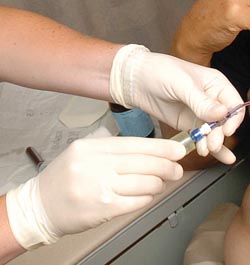
The Monroe Carell Jr. Children’s Hospital at Vanderbilt is expected to be deemed latex safe within the next two months.
photo by Francis Gardler
Children’s Hospital making move to latex-free materials
The Monroe Carell Jr. Children's Hospital at Vanderbilt will become “latex safe” within the next 60 days, drastically reducing the risk of allergic reactions for patients and staff.
Last month, the hospital began switching the purchase of materials, including gloves and catheters, to all latex-free varieties. It will take a couple of months to exhaust the small amount of existing latex materials before they are replaced with the new supplies, but once that process is complete, Children's Hosptial will be the first on the VUMC campus, and one of the first hospitals in the country, to become “latex safe.”
“Especially for children with spina bifida and chronic urinary problems, latex can be very dangerous,” said Jay Deshpande, M.D., medical director for Performance Management and Improvement at Children's Hospital. “We have had policies to protect children we knew to be sensitive, but this new policy helps protect children who haven't developed an allergy yet.”
Robert Arrindell, materials manager at VCH, said the cost difference between latex and latex-free products is nominal; the challenge has been finding replacement products that function as well as their latex counterparts. Doctors say latex-free products have reached the point where the quality is very high.
“We have actually been close to latex safe for some time now,” Arrindell said. “Before the conversion began this year, the neonatal intensive care unit both at Children's Hospital and the Stalhman unit at Vanderbilt University Hospital were already latex safe. The Pediatric Critical Care Unit (PCCU), Pediatric Emergency Department and all acute care areas were 90 percent latex safe. The other 10 percent account for catheters which are currently latex but are being changed over to latex free soon.”
The Medical Center has had a blanket policy since 1989 to identify adults and children with latex allergies and use supplies that are latex free when possible. VUH, for example is about 90 percent latex safe for all patients. For a person to develop a latex allergy, they must have repeated exposures to the natural rubber. It is rare for adults to develop the allergy unless they work in a hospital setting; and there are policies in place to protect workers from developing the allergy.
But children and infants can develop their first allergy to latex while being treated at a hospital, and then face a lifetime of avoiding the material. For that reason, the Performance Management and Improvement staff at VCH has decided to remove the option of using latex supplies on patients in general, whether they have the allergy or not.
“Latex safe” is the catch phrase being used in the hospital industry to describe a policy of purchasing only latex-free varieties of supplies whenever possible. Children's Hospital cannot be termed “latex free” because latex alternatives are not yet available for all products and because the public commonly brings latex products into the hospital in products like pencil erasers and clothing.
Natural rubber latex is produced from the sap of the Malaysian rubber tree, and is found in more than 40,000 medical and household products. Adults and children can become sensitive to the proteins in natural rubber latex. Symptoms of a latex allergy can include skin rashes, nasal congestion, itchy or teary eyes, facial swelling, chest tightness, and/or breathing difficulty. Reactions can range from mild to life threatening.













